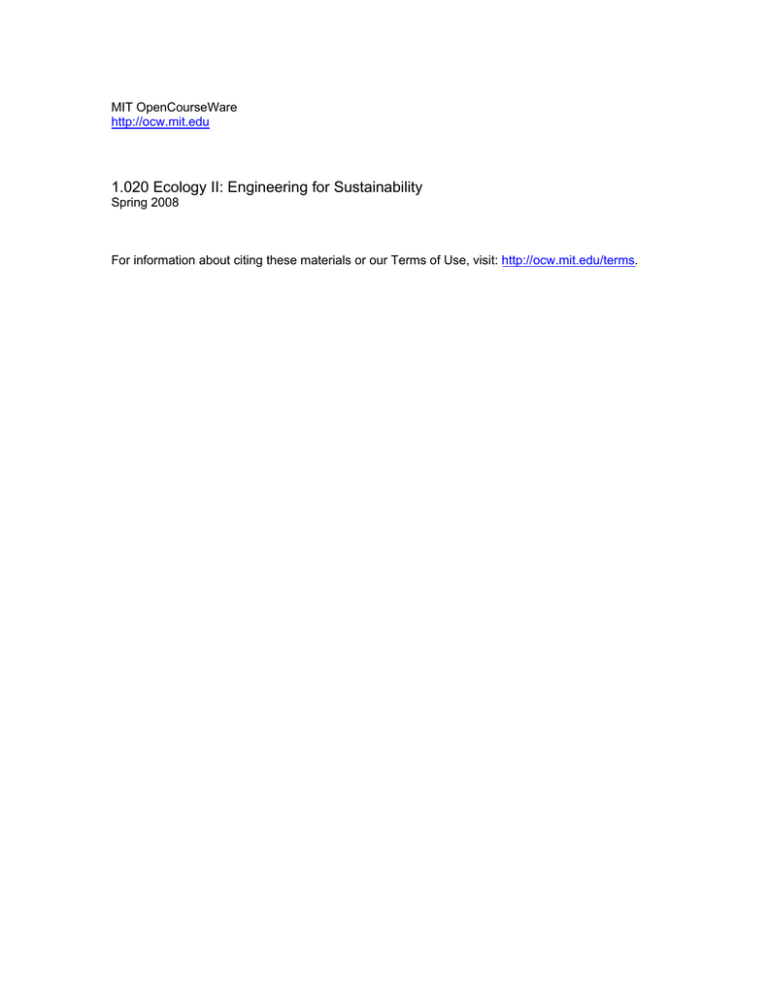1.020 Ecology II: Engineering for Sustainability MIT OpenCourseWare Spring 2008
advertisement

MIT OpenCourseWare http://ocw.mit.edu 1.020 Ecology II: Engineering for Sustainability Spring 2008 For information about citing these materials or our Terms of Use, visit: http://ocw.mit.edu/terms. 1.020 Ecology II: Engineering for Sustainability Lectures 08_16 & 08_17 Economic Optimization, Derived Demand, Irrigation Motivation/Objective Develop a model/optimization procedure to determine the most economically productive way to allocate limited resources (land and water) for a farm growing 2 crops. Approach 1. Formulate allocation of limited resources as an optimization (quadratic programming) problem. Define objective (maxmize crop revenue, $), decision variables (land for each crop, ha), constraints (water and land limitations). 2. Put problem in a form suitable for solution in MATLAB. Construct all matrices required by MATLAB quadprog function. 3. Solve problem in MATLAB and evaluate sensitivities to resource constraints (also called shadow prices or Lagrange multipliers) for a range of water availabilities. 4. Consider how problem inputs (crop yield, crop water demand, crop prices, etc.) affect solution. Concepts and Definitions Needed: Resource allocation -- to obtain derived demand we focus on effect of resource limits on crop revenue. General resource allocation optimization problem: Objective function Maximize Frev ( x) = Net revenue(x) ($) x x = vector of quantities produced Such that following constraints hold for each resource: Resource used (x) ≤ Resource available Upper and lower bounds on x Physical constraints (e.g. mass, energy balance) Decision variables Inequality constraints Inequality constraints Equality constraints For 2 crop example this becomes: Objective: 2 Maximize Frev ( x) = ∑ pi Yi xi , pi = Price crop i ($ tonne-1) Yi = Yield crop i (tonne ha-1 season-1) i =1 Frev ( x) = revenue ($ season-1 ) x = [ x1 x2 ] , xi = Area crop i (ha) Yi = Yi 0 − d i xi Yi 0 = nominal yield (tonne ha-1 season-1) d i = yield reduction coef (tonne ha-2 season-1) Constraints: (MCM = 106 m3) , wi = Water rqmt crop i (MCM ha-1 season-1 ) Water: Land: 2 ∑w x i i =1 2 ∑x i =1 i i ≤ Q = water available (MCM season-1 ) ≤ Lavail = land available (ha) Nonnegativity: xi ≥ 0 i = 1, 2 10 Input Arrays for MATLAB (quadprog): Quadprog format: 1 T T Find decision variables x that minimize Frev (x) Minimize Frev ( x) = x Hx + f x x 2 such that : Ax ≤ b Inequality constraints Equality constraints Aeq x = beq xlb ≤ x ≤ xub Lower and upper bound constraints For 2 crop resource allocation problem (converted to minimization problem): 0 ⎤ ⎡ Q ⎤ ⎡ p1 d1 ⎡ w w2 ⎤ b=⎢ f = −[ p1Y10 p 2Y20 ] H = 2⎢ A=⎢ 1 ⎥ xlb = [0 0] ⎥ ⎥ p2 d 2 ⎦ L avail ⎣1 1⎦ ⎣ 0 ⎦ ⎣ Aeq = beq = xub = [] (unused for this example) Make sure that H is a symmetric matrix. ∂F ( x ) Shadow price of water = λ (Q ) = rev , ($ m-3) ∂Q Plot of λ (Q ) vs Q gives derived demand (a curve). Crop Allocation Example Results Crop 2 (lower water rqmt) preferred over Crop 1 (higher value per ha), especially when water is limited. Plots show that revenue increases at a diminishing rate as available water increases Demand for water decreases as available water increases Results depend strongly on yield loss coefficient 11


